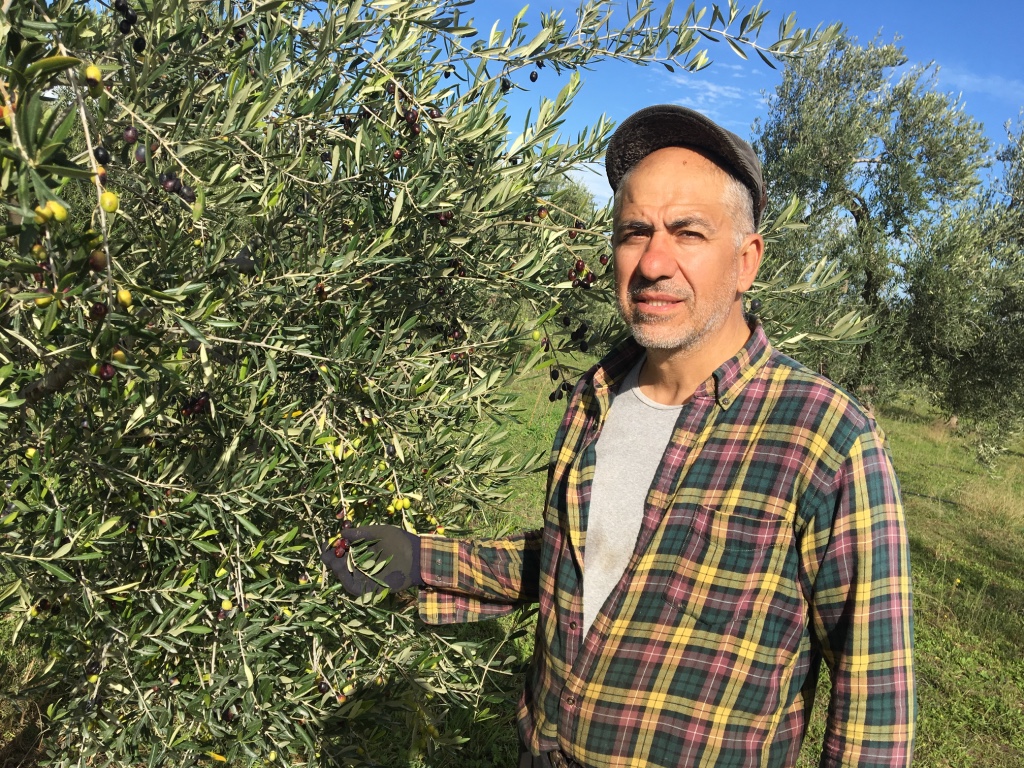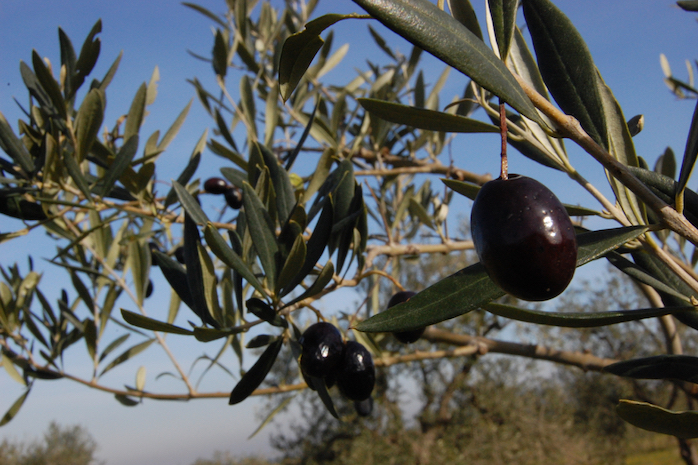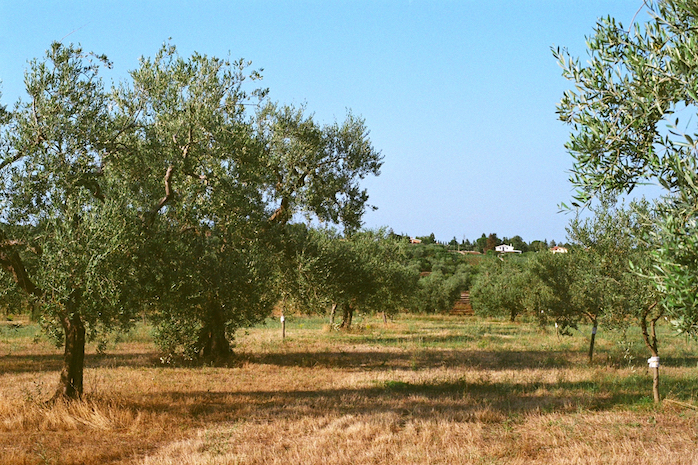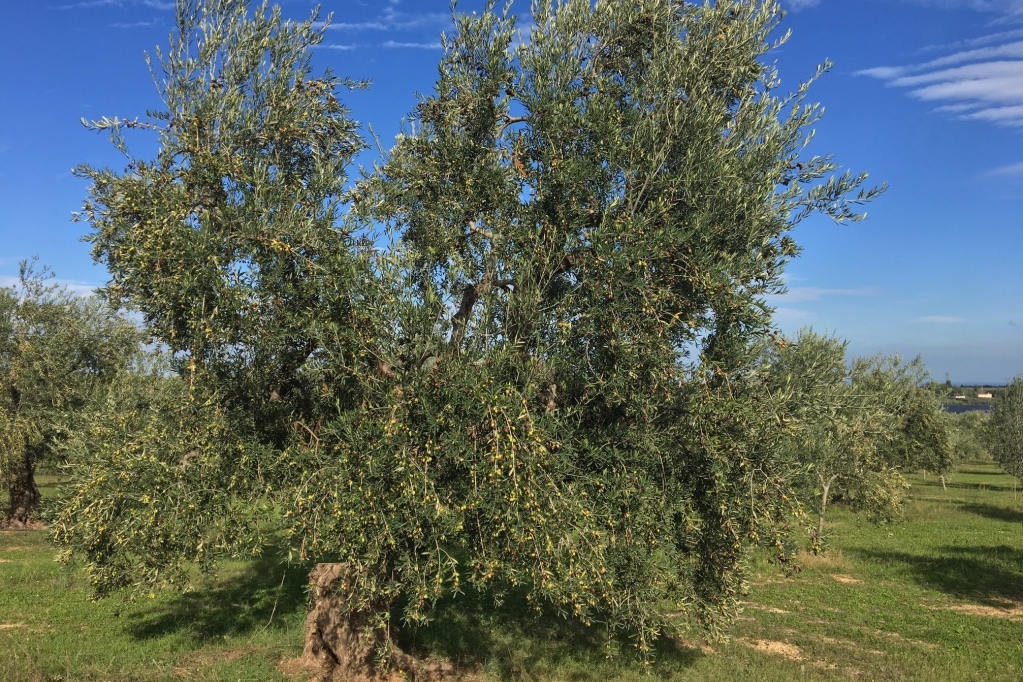トレリさんのオリーブオイルは、「美しい樹」を意味するコラートという町で作られている。イタリア南東部プーリア地方に紀元前からある場所で、世界遺産のトゥルッリがある観光地アルベロベッロの近く。トゥルッリは、石灰で作られた真っ白な壁に、円錐型に石を積んだとんがり屋根が特徴的な建築群と街並みの総称で、約1,500軒が集まっている。
街から離れたトレリさんの農場にも個体のトゥルッリが建っており、現代文明の影響が少ない国立公園の丘に位置している。適度に乾燥した温暖な気候と、水捌けの良い石灰質の土壌に恵まれ、オリーブの木を育てやすく、プーリア地方での生産量はイタリアで一位。家族代々でオリーブ農園を持つことは、イタリアの田舎の方ではわりと普通なことで、自分たちが食べる以外は収穫した実を業者に売り、それを他の業者が搾油して、ボトリングし、また別の業者が輸出し、販売するというオリーブの消費の仕方が多いそうだ。トレリさんも祖父の代まではそのようにしてきたが、現在はコラティナ種というプーリア地方原生の品種のみを、無農薬で単一栽培している。
「きっかけは、父が日本国内で出回っているオリーブオイルの実情を知ってからです。自分が食べているイタリア産のオリーブオイルが、純粋なものではないことが分かり、調べていくうちに、イタリアの現法律ではエクストラバージンオリーブオイルが40%でも入っていれば、ほかの油が混ざっていても流通されてしまったり、そもそも日本のマーケットでは、良いものが存在しないと気が付きました。父は、日本人にとって日常の食生活に欠かせない醤油のような調味料が、ぞんざいな扱いだとわかり、ショックを受け、健康や食文化に対して気をつけなければいけないと思い立ち、自分で作り始めました」。
そして今から13年前、トレリさんの父はひとりで近所にあった荒れた畑を開拓し、苗木からオリーブの木を仕入れて栽培。満足のいく収穫ができたのは、9年前。楽をしようと思えば、化学肥料を入れたり妥協はできたが、コストや手間のプロセスを度外視し、時間をかけて納得できるオリーブオイルを作った。今では、親戚総出で集まり、手摘みで収穫し、搾油、ボトリング、流通から販売までを、ほぼ家族経営で行なっている。現在は、EUオーガニック認証と有機JAS認証を取得している。
「オリーブの実は、枝から離れると酸度が上がってしまうので、熟して地面に落ちる直前に朝4時から手作業で収穫しています。洗浄した後、一時間以内に直径1.5mの石のローラーで砕きます。オイルに含まれるオレイン酸は熱に非常に弱いため、低温のまま圧搾し、遠心分離によって水分を取り除き、1ヶ月から1ヶ月半くらいかけてゆっくり寝かせて沈殿させた後、濾過しないままボトルに詰めます。一番こだわっているのは、古代から伝わる搾油方式です」。
この方法でボトリングすることで、ビタミン類や繊維質を多く含む自然な品質を最上の状態で保存することができるそうだ。農薬を使わない有機生産は、伝統的な沈殿方法を取り入れたやり方が一番、理に適うことを発見した。出来上がった純粋なオリーブオイルは、うす黄緑を帯びた黄金色に輝き、オリーブのジュースのような風味。独特なエグミも無く、ほのかな苦味がある爽やかな味わい。
「ボトルにはメイドインイタリーと書いてあっても、どんな過程を通り、誰が携わったプロダクトなのかは分かりませんよね。私たちが目指しているのは、生産過程の透明性。それがお客さんへの信用を得ることだと思っています」。
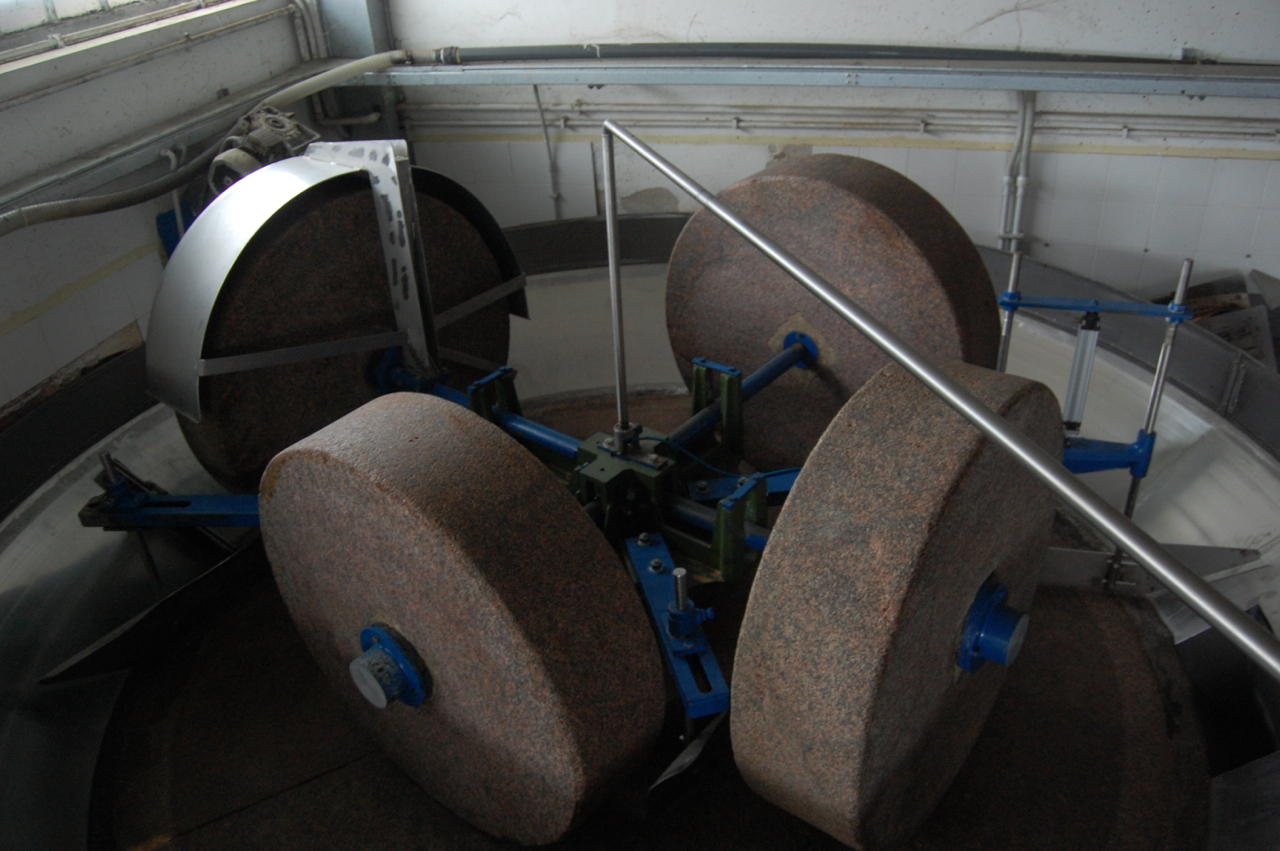
現在、小売りは食への意識やパーマカルチャーやフェアトレードの商品を扱っている三宅商店などで販売している。オーガニックにこだわるイタリアレストラン、ナプレグループなどにも卸しており、実際に現地での生産過程を見てもらい、信用された関係を築き上げている。
トレリさんの作った純度の高いエキストラバージンオリーブオイルは、生で食べることをおすすめしている。料理の仕上げにかけると、風味や栄養が失われずにそのまま体に摂取することができる。イタリア料理のみならず、様々な料理との相性が合う。醤油とも相性が良く、和食にも万能だ。「おかずのクッキング」というTV番組で料理研究家の土井善晴さんは、お味噌汁にパンを添えてオリーブオイルをかける食べ方を提案していた。
また、オリーブオイルの他にも、品種改良を行っていない古代種のアーモンドを作り、販売を開始したばかり。古代アーモンドとは、現存するアーモンド7種類のうちファッジョーラ、トゥオノ、ジェンコ、スーペルノヴァの4種類の発祥は、トレリさんの農園があるプーリア地方で、品種改良を行っていない原生種。オレイン酸やビタミンE含有量が高く、糖度をはじめ栄養価が損なわれていない。取材時にアーモンドを試食させていただくと、独特な歯ごたえと噛めば噛むほど甘みのある、ほんのり杏仁豆腐を彷彿させる味。古代ローマ時代から食されてきたそうだ。
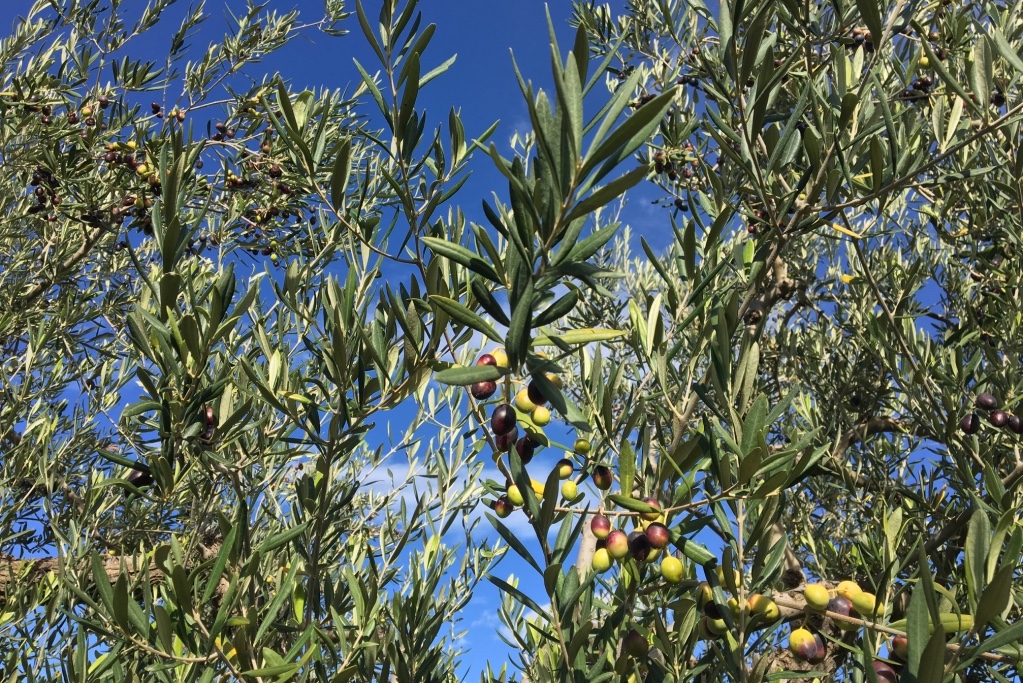
トレリさんは最後にこう話してくれた。「今の時代は、大きな流通よりも個人の視点が入った物流の方が、新しい価値を創造できると思います」。
2011年に大震災が起きてから、作り手の顔が見えるものが安全な食だと思うようになると、衣食住の中で衣服などのファッションの比重よりも、食べ物や暮らしに意識が集まってきた風潮に思えた。巨大な流通システムよりも、小商いやコミュニティマートなど、身の回りの人間関係でのライフスタイルにまつわることがフューチャーされるようになった。食への覚醒は、今後さらに考えさせられる問題だろう。これからは、本能で体に良い自然の素材を嗅ぎ分ける能力が必要だと思っている。
Torelli’s olive oil is produced in the town of Corat which means “a beautiful tree.” The history of the town goes back to BC. It is located near Alberobello, a tourist town which is famous for “Trulli” the world heritage site, in the Puglia region in the southeast of Italy. Trulli is a collective term for a group of about 1500 historic buildings and its townscape characterized by conical stone roofs on pure white walls made of lime. Torelli’s farm, too, has a single trulli building (or trullo) within its site. The farm is situated away from the city, on the National Park hill with hardly any touch of modernity. The land is blessed with moderately dry and warm climate, and well-drained dry calcareous soil makes it the best place to raise olive trees. The Puglia region is respected for the highest olive production in Italy. Running a family olive farm for generations is nothing special in the Italian countryside, many people do it. Farmers keep only as many olives as their family can eat, and they sell the rest of the harvest to dealers. Processers buy it, squeeze it and bottle it, and other companies export and sell it. This is the conventional structure of the local olive industry, according to Torelli. Torelli’s family farm, too, had been following this manner until his grandfather’s generation. Today, however, they are different. The family focuses on cultivating only one variety of olive, known as “Coratina,” which is a native breed of the Puglia region, and the farm uses no pesticides.
“The first turning point was when my father got to know the facts about olive oil sold and consumed in Japan. He noticed that the Italian olive oil consumed in Japan didn’t have a good quality at all. He studied further to know that the Italian law permits processors and sellers to add other types of oil as long as the product contains more than 40% of ‘extra virgin olive oil.’ Because of that, high-quality olive oil was totally unavailable in the Japanese market. He was shocked to know that such an essential seasoning for Japanese everyday diet, as basic as soy sauce in a sense, was being so badly treated. He thought that people must pay more attention to their health and food culture, and he decided to make a better product himself.”
Thirteen years ago, Torelli’s father pioneered an abandoned field in the neighborhood on his own, purchased small young olive trees and planted them. It was nine years ago when he first got a satisfactory harvest. It was possible for him to increase the harvest more easily by using chemical fertilizer, but he chose not to. He put his top priority on the quality of olive oil, and he didn’t mind taking a long time and paying extra cost to achieve his aim. Today at Torelli’s farm, many relatives cooperate to harvest by hand picking, and then to extract the oil, bottle it, ship and sell it. They do almost everything in their family business. And they have obtained EU organic certification and JAS organic certification.
“The fruit of olives gains acidity as soon as it leaves the branch. To avoid this, we start working in the field at 4 in the morning and harvest by hand just before ripe olives fall to the ground. After washing, we crush them within one hour, using a stone roller which is 1.5 meters in diameter. Oleic acid contained in olive oil is delicate and can be easily deteriorated by heat. So we squeeze olives at low temperature, remove moisture by centrifugation, wait one month to 45 days, let it slowly settle, then we bottle it without filtration. We are sticking very closely to the traditional extraction method transmitted from ancient times.”
This method can preserve the olive oil in its best condition, in its original quality which has various vitamins and fibers, Torelli said. They also discovered that organic production without pesticides is the best fit for the traditional settling method. And their completed pure olive oil shines like gold with a yellowish green tint, and a taste like olive juice. It has no unpleasant astringent taste, but has a refreshing mild flavor with a faint bitterness.
“Even if ‘Made in Italy’ is written on the bottle, you can’t see who was involved in its production nor what sort of process it has passed through. Our aim is to secure full transparency in every production process. I believe that would eventually raise our credibility among customers.”
Today Torelli’s organic olive oil is sold in Japan through retailers such as MIYAKE STORE, which is highly conscious of healthy foods, handling products of permaculture and fair trade. They also sell wholesale to Napule, which runs organic-based Italian restaurants. To build mutual trust, their business partners are invited to their farm to see the real scene of production.
Torelli’s high purity extra virgin olive oil is recommended for eating without heating. One of the best ways is to use it at the end of cooking. Its flavor and nutrition can be kept as they are, which can be ingested to the body efficiently. The oil is compatible with various dishes besides Italian cuisine. It goes very well with soy sauce. A perfect fit for Japanese food. Yoshiharu Doi, a cooking specialist, introduced a unique way to eat slices of bread and olive oil together with miso soup, on his TV program named “Okazu (side dish) cooking.”
In addition to olive oil, Torelli’s farm has just started selling its original breed of almond, which has not been modified for centuries. Among the seven existing types of ancient almonds, Fragiulio, Tuono, Genco, and Supernova are native to the Puglia region where Torelli’s farm is located, and these varieties have not received any breed modification throughout history. Ancient almonds contain a large amount of oleic acid and vitamin E, and other nutritious values such as sugar components that are also higher than conventional varieties. I ate Torelli’s almonds during my interview. They were crunchy, and a delicate sweet flavor came out bite by bite, and its flavor reminded me of Chinese almond pudding. They are the same as the almonds ancient Romans loved to eat.
“Today, smaller-scale supply based on unique personal view of value can create bigger new values than conventional mass-product supply does,” Torelli said at the end of interview.
After the Great East Japan Earthquake in 2011, I myself began to think that safer food can be obtained through small-scale supply where I can see the background of products. The society, as a whole, too, seems to be shifting its priority to safety of food and living, rather than only fashion or convenience. Instead of consuming from the mass supply system, people are paying more attention to alternative systems and lifestyles based on individual relationships, such as small-scale business and community markets. Our awakening has just started, and this movement will further continue. We are required to utilize our insight further to discover more natural, healthier ingredients.
